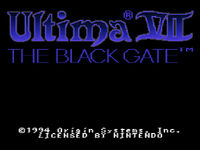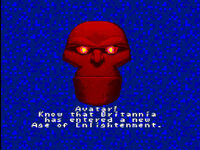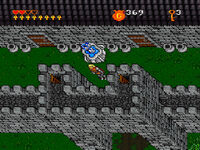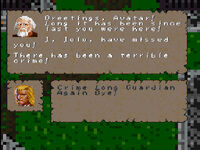
Title Screen
Ultima VII was the last Ultima released to a console by Origin, and a version of the game was released for the Super Nintendo in 1994.
Description[]

Ultima VII SNES
The technical limitations of the Super Nintendo made it necessary to cull a fair amount of the content which had been present in the PC version of Ultima VII, which had been approximately 20 megabytes in size and had featured VGA graphics, a full soundtrack and a deeply interactive game world. In order to compress the game into a one-megabyte module, a great deal of material had to be removed - resulting in a product with simplified graphics, a limited musical score and a greatly simplified world map.
In addition to this, Nintendo of America appeared to impose a great deal of editorial control over the games content - leading to the removal of many of the original versions "darker" aspects for the sake of keeping the game "family friendly." As such, the game's plot was changed from focusing on a spree of mutilation killings to focusing on a rash of unsolved kidnappings, and macabre or sexual imagery was removed.
Nintendo Power praised Ultima VII's interface, sound, and exploration, but criticized the uncomfortable combat and movement. The game received a 2.9/5 for graphics and sound, 2.5 for play controls, 2.9 for challenge, and 3.1 for play and fun.[1]
In 2006, this version of The Black Gate was made available on the Sony PSP by Electronic Arts as part of their Retro Replay package, along with thirteen other older EA games.
Changes from the Original[]

The Intro

In-game
- The game doesn't support a party systems, leaving player only able to control the Avatar - who is defaulted to their male version and who cannot be named.
- Both the introduction and ending have been greatly reduced in size, and are limited largely to narrative text rather than animations.
- The game world is much smaller than the original, and there are far fewer NPCs - all of whom lack daily schedules. Many characters have been replaced or altered drastically to conform to the new story, and the amount of dialogue in the game has been reduced.
- The combat system is less automated and plays similarly to many action-adventure games. To showcase this aspect of the game, a number of dungeons have been added to the world map and most plot-important items must be retrieved from them.
- The function of the day and night cycle has changed, with visibility being greatly reduced at night and certain items (such as the bedroll, or magic lantern) being only usable after sundown.
- The game is divided into outdoor and indoor maps, which prevents the player from using the isometric view to look inside of unentered buildings.
- The spell-casting system is streamlined such as to exclude reagents and spell purchasing, and there are only sixteen available spells instead of seventy-two. Spells not seen in the original game have also been added, such as Water Walk and Lifting.
- Conventional ship travel is not available, limiting exploration to islands which may be reached via an item known as the Magic Boat. The Moongates are also completely non-functional throughout the game.

Talking to Iolo
Trivia[]
- One very strange piece of merchandise associated with the game is the Ultima VII Boomerang, which was sold in Japan. The Boomerang is a hidden weapon in this port.
See Also[]
- Ultima VII Transcript (SNES)
- Ultima VII (SNES) Magic
- SNES Map for Ultima VII
References[]
- ↑ "Now Playing". Nintendo Power (Ultima VII). Jan. 1995. Pages 106, 107.
External Links[]
- Silellak played through the entirety of Ultima VII for the SNES, and recorded his experience at: here.
- He also has recorded the last 5 minutes here.
| Console Ports | |
|---|---|
| Games | Ultima III ☥ Ultima IV ☥ Ultima V ☥ Ultima VI ☥ Savage Empire ☥ Ultima VII |